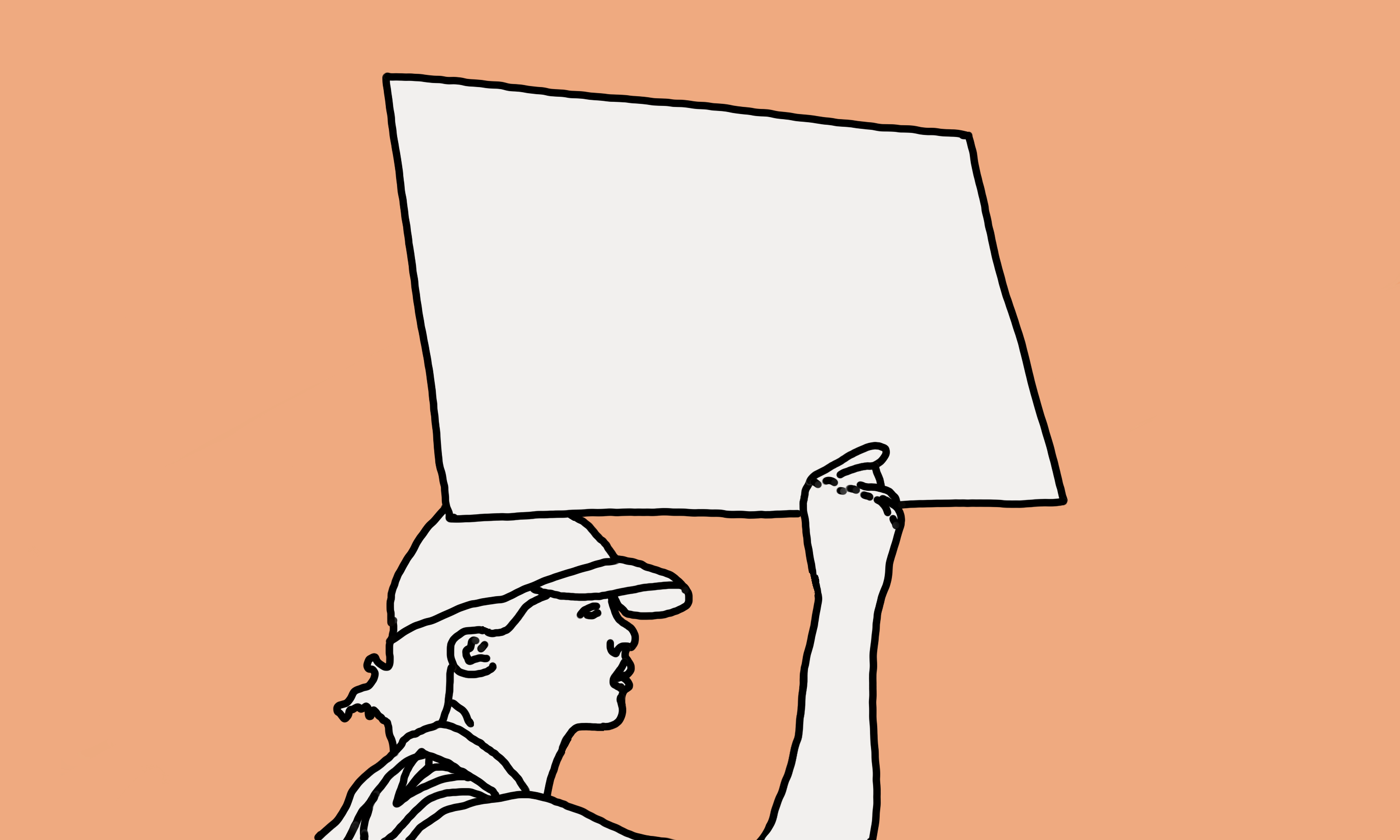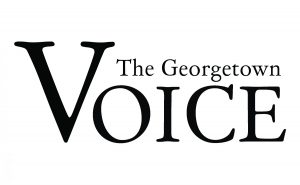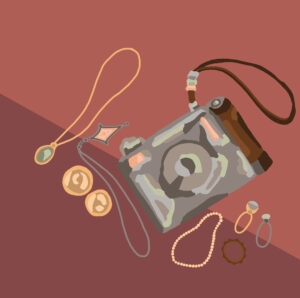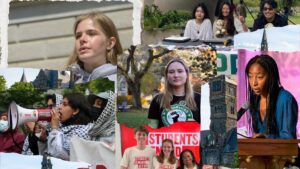Georgetown’s relationship with activism has never been a simple one.
When new Hoyas walk through the gates at the intersection of 37th and O, they can expect to be bombarded with opportunities to advocate for themselves and others—for changes in curriculum, for university support, for reproductive rights, for protections for survivors of sexual assault, for anti-racist policies, for equitable resources. Over three dozen Georgetown clubs are dedicated to advocacy, with members numbering in the thousands. This constant cycle of activists is the backbone of Georgetown, holding up fellow students even when they cannot see it.
This legacy of protests and advocacy on college campuses did not just begin with our classes. Truthfully, it would be impossible to identify the first activist on Georgetown’s campus, and a comprehensive timeline of each push too easily misses the thread of rage tying current students to those from generations past—a thread that met the needle in earnest fifty years ago, on May 6, 1970.
That Wednesday, undergraduate students at Georgetown began a strike that would last for just over a week. The strike was at once a response to U.S. military action in Cambodia and Vietnam, and to the massacre of student protestors at Kent State University by the National Guard. The Student Senate began the strike, calling for a two-day boycott of classes. Following those two days, faculty representatives voted overwhelmingly to suspend classes for an additional week. All remaining classes for that semester were suspended, and students never sat for finals, which has not happened since.
Michael Winship (COL ’73) was a freshman at Georgetown that year. When he first arrived on campus, in the fall of 1969, the anti-war movement was at a high point. Students went to a national rally in the city that November, activists began passing out flyers on campus, and Steven Pisinski (COL ’71) left The Hoya in 1969 to found the Voice, which Winship went on to join. New Voice staffers, many of whom were former Hoya writers, cited concerns the only paper on campus was too conservative, especially in its response to the Vietnam War, to explain their exodus.
The already-present momentum reached a head on Monday, May 4, when news reached Georgetown about what had happened at Kent State.
Winship had always been against the war, and to hear him tell it, everyone else knew he was too. Once he saw the deaths at Kent State and Jackson State, a historically Black college, the issue began to consume his life as it did the campus.
“It was such an incredible idea to get your mind around, that they were actually killing college students,” Winship said. “There was this slowly building desire to do something. When the National Guard fired on kids at Kent State University, that really was what triggered the events that led to the national student strike.”
Students across the country erupted. On the Hilltop, the next two days were filled with gatherings, from chats in dorm halls to a massive meeting in Gaston Hall open to all students that lasted until the early hours of the morning. Every student who wanted to speak was given the chance, and when students finally walked back to their dorms in the middle of the night, it was clear—Georgetown students would be taking a stand against the Vietnam War.
***
Even before the shootings at Kent State, Mike Thornton (COL ’71) knew there would be a strike.
Then the president of the Georgetown student body, Thornton had run on a platform on increasing students’ say in university governance. When he entered office, Thornton was hoping to lead a number of initiatives, including reforming the faculty tenure system, giving students more recourse in the disciplinary process, and creating a council with representatives from the university and student and faculty governments to handle university affairs. The administration had responded passively for months, so the Student Senate voted that Sunday, May 3, for students to strike for one day in support of eight demands.
Those demands, as reported by The Hoya at the time, were to create a committee on faculty rank and tenure with students as members; give amnesty to six students placed on academic probation for “interference in ROTC classes;” remove academic credit from the ROTC program; begin an investigation into university governance; request a resignation from Rev. Robert Judge, the dean of students, for violating students rights; reduce Georgetown’s pollution; and launch an investigation into working conditions at the university. Only the last demand, which read “That the U.S. Government cease its escalation of the Vietnam War into Cambodia and Laos: that it immediately withdraw all troops from Southeast Asia,” was directly related to the Vietnam War.
The resolution, which passed the Senate 20-9, initially called for a one day boycott on Friday, May 8, later moved to Wednesday. However, by Tuesday, tensions amidst students began to run high. Jeffrey Miller, Allison Krause, William Schroeder and Sandra Scheuer had been killed at Kent State, yet conservative students wanted the Senate to reconsider their position.
It was this meeting that would fill Gaston Hall late Tuesday night. “We showed up at Gaston Hall thinking there probably would not be that many people there, and actually it was entirely filled with students,” Thornton said. A member of the group attempting to reverse the strike got up to introduce the bill, and then Thornton took the stage.
“Everybody started yelling strike and lifting their right hand in unison in a fist, like a cheer,” he said. Thornton knew the strike was still on.
That same night, the Graduate Student Organization met and agreed to strike. They did so in support of the New Haven demands, which called for the government to “end
its systematic oppression of political dissidents and release all political prisoners such as Bobby Seale and other members of the Black Panther Party” and for universities like Georgetown to “end their complicity with the U.S. War Machine by the immediate end to defense research, the Reserve Officers Training Corps, counter-insurgency research, and all other such programs.” A group of 450 law students voted to strike as well and officially held President Richard Nixon and Vice President Spiro Agnew responsible for the deaths at Kent State.
Though the strike, supported by Georgetown University Radical Union, was officially about both university and national issues, Thornton said, once the nation’s attention turned to Vietnam, so did the students’.
“It started with campus issues, and then became more focused, or predominantly focused from an emotional standpoint, on the protest against the war,” he said. “That became the preeminent issue on everybody’s mind.”
The student government printed out black posters that read in small white letters “ain’t gonna be no school Friday.” The newly-created Voice released an issue with a red fist on the back reading “strike.” Wednesday and Thursday were filled with rallies and teach-ins. Rev. Robert Henle, then president of the university, told The Hoya he did not see any sense in the strike and had no plans to cancel classes. “Final examinations for undergraduates will definitely not be cancelled,” the Friday edition of the paper read.
***
Before Tom Devine (COL ’73) got to Georgetown for his freshman year in the fall of 1969, he received a reading list. This was not, on face, strange. What was odd, however, was that the list was populated with titles like The Autobiography of Malcolm X, “really radical texts,” as Devine called them.
The list, which was not an official list, but rather recommended reading from student activists made to look like a university-sanctioned assignment, was just one indication of the electricity of the campus Devine would be stepping on to.
“The student body of the ’60s was just as liberal as most progressives today,” Tony Kawas (COL ‘71), a former editor-in-chief of the Voice said. “They wanted racial justice. They did not want to go fight a war that had no meaning to the country. They wanted to be iconoclasts. They smoked pot. They had sex. None of this may be new now, but it was in the ’60s.”
At the time, campus was home to few conservatives or supporters of the war. Devine was, at first, one of these. In the May 8 edition of The Hoya, he penned a letter to the editor entitled “Disgust,” in which he called the student strike “an amorphous catch-all, inadequately developed and justified.”
“I thought it was a fight for freedom, that people risked their lives to defend freedom,” he said 50 years later of the Vietnam War. But once Devine saw the deaths at Kent State, and at Jackson State University in Mississippi a few weeks later, he began to see the violence perpetrated overseas as hypocrisy.
“This was a challenge to freedom at home which was supposed to be the whole point of the war,” Devine said. “We couldn’t tolerate soldiers killing us for exercising our free speech rights.”
While Devine changed his mind in the days leading up to the strike, eventually participating in protests and hosting fellow demonstrators in his dorm room, the strike was not without its critics. In the same issue of The Hoya Devine contributed to, three other students expressed their opposition to the strike, including Ellen Stanton Mulaney (COL ’71), who would later become the mother of comedian John Mulaney (COL ’04).
An editorial by The Hoya’s board expressed concern about the fusing of two potentially disparate movements, on-campus complaints and anti-war demonstrations, reducing the student’s commitment to both. Other students opposed the strike for a simpler reason—they supported the war.
Though by the end of the summer the concern of the editorial board would be borne out, it was more immediate criticisms from the administration that would threaten the strike in its early days.
After the issue of the Voice featuring a red fist came out, Kawas, then the editor-in-chief, went to see his dean about a class he was taking. They never got to that discussion. “The dean picked up the newspaper with the red fist on it and said ‘are you responsible for this, get out of my office,’” Kawas said.
Criticism came from the highest levels of the university. After the student government called for the strike, Henle called Thornton and his vice president, Joe George, into his office. According to Thornton, Henle urged the students to stop the strike in its tracks. “He basically looked at us and said ‘the student body cannot call for this university to suspend student classes, and this strike has to be stopped and I want you to stop it,’” Thornton recalled.
“And I looked at him and said ‘Father Henle, this is bigger than you and me, unfortunately, this can’t be retrofitted, it’s now a national student strike.’”
Despite Henle’s best attempts, the student strike pressed on, and with the support of the faculty, remaining classes were cancelled. Finals that spring were optional, and to Winship’s recollection, infrequently taken. What was previously academic time was spent organizing rallies and protests, most notably at the National Mall on May 9.
Students from across the country flocked to D.C. and found refuge at Georgetown. The university hosted hundreds of demonstrators overnight, and dorms teemed with visitors sleeping in common rooms, hallways, and anywhere else they could find room. Hoyas picked through sleeping bags and protest signs on their way to the bathroom in the morning.
“You could walk into your dormitory room and find ten people sleeping on the floor,” Winship recalled. “We were all very much at the center of that.”
The student government, led by Thornton, found hosts for demonstrators and supplied them with tents. Food was delivered to campus from local vendors. After a threat of violence was made, students began to patrol campus with walkie talkies to ensure everyone was safe. For those few days, a student anti-war community began to form in earnest.
“There was a lot of exhilaration and excitement, it was an intense moment. We were living at one of history’s crossroads,” Devine recalled.
Before the protest on May 9, Winship trained to be a marshal, which included learning how to administer first aid to demonstrators. This was difficult since students weren’t sure what they would be facing.
“It was, you know, for everything from sunburn to gunshot wounds,” Winship said.
Despite these concerns, the demonstration would remain relatively peaceful and draw over 100,000 students to the center of the city. Though this was historic in sheer numbers and nature, it was also relatively short-lived—it was summer, and soon students began returning home. Winship recalled hanging around the city for as long as he could, working with the New Democratic Coalition until the money ran out and he left.
Slowly, Winship began to worry that the predictions of The Hoya’s editorial were coming true. Though he had taken issue with the characterization of the movement as a “frisbee revolution,” he could not deny students were beginning to pick up other pastimes to fill their increasingly sunny days, and Winship worried the defining moment had been a passing fad.
“The whole student strike was predicated on the notion that following that initial outburst, students would use the spring and summer, would use the time that they were getting sprung from classes early and from final exams early, and use that time to organize and mobilize and continue to get support against the war,” Winship said.
Even as the action began to drop off, the events of 1970 hung over the campus, awaiting its students’ return in the fall. Winship recalled new discussions of the privilege of being white and wealthy, especially in regards to the draft, which students could avoid as long as they remained enrolled at Georgetown. The moment male students graduated, they were told to go for their physical.
“That was sort of always present in everybody’s lives.”
***
For Kawas, the military was not an impending possibility. It was his present.
Kawas attended a military high school, and when he got to Georgetown, joined the ROTC. For his first two years there, this choice was hardly questioned. But by the fall of 1969, around the same time Kawas sustained an injury that forced him to leave the organization, that changed. Of all the local demands presented as part of the strike, the removal of the ROTC from campus was by far the most pervasive, according to Kawas.
“I remember a real shift, a real antipathy for the ROTC developing,” he said.
At the time, Georgetown’s ROTC, especially the elite rifle drill team known as the Spraker Rifles, was seen as a manifestation of a pro-war agenda on campus. The group had most recently made national news in 1962 when, at a military film premiere performance, one unlucky cadet accidentally stabbed then-United States Attorney General Robert Kennedy’s arm with his bayonet. “I got one,” the cadet reportedly said. Kennedy needed no medical attention, but the episode made the front page of The Washington Post the next day.
Seven years later, the ROTC would be a front-page issue again, as 50 students occupied the ROTC offices for a sit-in, passing around anti-war materials. Those opposed to the organization pronounced the group’s nomer as “ROT-C,” likening the on-campus military presence to a fascist regime.
Though, according to the Hoya Battalion website, a student referendum found that 68 percent of students were in favor of the ROTC remaining on campus, a 1970 disruption of ROTC classes by other students prompted the university to discontinue academic credit for the courses. A later proposal would allow the ROTC to form its own academic department, and give six credits to cadets in their senior year.
Despite the eventual partial rollback of the university’s acquiescence to protestors on the issue of the ROTC, it was by far the local demand that got the closest to success. Though the student strike would come to an end in the fall of 1970, demands unsatisfied, the feeling of anger and betrayal by the university would not, and in 1971, tear gas entered the front gates.
***
John Membrino (COL ‘73) spent his free time freshman year knocking doors in the Georgetown neighborhood, asking his neighbors to oppose the war. As a result, Membrino also spent his freshman year getting used to being called “silly.”
Despite the ridicule, Membrino preferred knocking doors off-campus because, unlike other students, he didn’t see many opportunities to engage in on-campus activism before 1970, especially when he compared Georgetown to American and George Washington universities. Though the activism ramped up for that May, when students returned to campus in the fall, some of that inaction did too.
By that time, Nixon had agreed to stop bombing Cambodia, one of the flashpoints for the original protests, and the campus began to calm down. Involvement in both activist and student government declined throughout the semester, Thornton remembered. “That fall there was a noticeable difference,” he said.
But then, police chased protestors onto Georgetown’s campus on May Day, 1971.
Almost a year to the day the student strike was declared, Georgetown’s campus was once again the host of anti-war demonstrators, this time 3,000 of them who sought refuge on campus after having been driven out of their main base. The Metropolitan Police Department stormed campus, arrested protestors, and tear-gassed the campus.
Even before the protest, there were major concerns about the police presence both in the city and around Georgetown. The night before the protest, which was anticipated to be larger than most of the ones in the previous year, the city tried to shut down the event by blocking bridges into the city. Police closed Potomac Park, where protestors were camping out, and according to Winship, some came to Georgetown’s campus, spending the night on the athletic field.
The next day, Membrino was walking by the ICC when he was met with a bad dose of tear gas. The police had chased some of the protestors on to campus and were launching their tear gas throughout Georgetown. “A lot of people got caught, sort of collateral damage,” Membrino remembered.
Winship was down on M Street trying to cover the protests when the police began chasing demonstrators back towards campus. As he entered the gates, he ran through a wall of tear gas. To Winship’s memory, the police had told the university they would not come on to campus and that the university could provide refuge to protestors, but then they came anyway.
Devine, however, said some students felt the university knew exactly what the police were going to do. He watched the whole episode from his dorm window. “There was a deep sense of anger and frustration among the students for the university’s complicity.”
***
Marty Yant (SFS ’71) did not come to Georgetown to get arrested.
The Ohioan arrived in the fall of 1967 and watched the campus go through its evolution. Yant attended a few Young Republicans meetings but “was totally turned off by a guy named Paul Manafort.” By the end of the semester, he was involved in the anti-war movement.
In 1969, Yant was covering an anti-war protest for the Voice. He was standing with the rest of the press corp when one cop came up to him and asked him for proof he was actually a student journalist. Yant showed him his notes, and the cop went away, seemingly satisfied.
A second policeman approached Yant and asked about his press credentials. Instead of believing Yant, “he took my pens and my notes and threw them on the ground and arrested me,” Yant remembered. Yant was held in the cell at the main jail.
But instances like this did not dissuade student journalists from covering the protests. Membrino recalled a particularly moving demonstration he covered in 1971 when former navy lieutenant and future senator John Kerry accompanied a group of fellow Vietnam veterans against the war to the Capitol. They all threw their medals down on the steps, denouncing the war they had received praise for serving in.
“It was a very emotional thing to see all those veterans coming up and doing that,” Membrino said.
After Kawas printed the red fist on the back of the Voice, he and Yant continued to coordinate coverage of the protests, connecting with student newspapers across the country. They began sharing stories with a few papers based on who they knew, and reporters from other papers hosted Voice writers in their dorms if they were covering stories out of town.
“That kind of network was very beneficial, I think to everybody,” Yant said.
But as time went on, those papers would have fewer and fewer protests to cover.
The momentum of the 1970 protest and May Day would continue for a few years—in 1972, 600 Hoyas boycotted class to protest the ongoing war in Southeast Asia, holding a sit-in in Henle’s office. The university threatened to kick out everyone involved. Students opposed Nixon’s ultimately successful reelection campaign in 1972. The Black Student Alliance became more active on campus, Membrino said, and, in 1973, students protested tuition increases by piling 6,000 lemons in front of the office of the university president.
“There were always people handing out petitions on campus, and there was a demonstration every spring, it seemed like,” he said of his time on campus. But that didn’t mean Georgetown was destined to stay that way.
“Things go in cycles, I think,” Membrino said. “For the most part, Georgetown being the university it is, it’s the political and national environment that have a lot to do with whether students are active or not active on campus.”
Georgetown has been host to an increasingly progressive series of student movements over the last few years, from the movement to divest the university from fossil fuels to the Black Survivors Coalition’s calls for increased support of Black femme-identifying survivors of sexual assault. Over the last summer, students have called for the university to cut ties with the Metropolitan Police Department and abolish the Georgetown University Police Department. Students have been trying, for 50 years, to take the reins of the university, to have a voice on this campus they pour so much of themselves into.
But students would not again display such a massive show of unity. The Vietnam War would recede in the minds of many students, especially those who knew their chances of being shipped abroad were slim to none. However, the spirit of the early ’70s would never fully wane and the cycle would always come back around.The university sat, ready once again for a new generation of protestors, a new list of demands.
And they have come.





